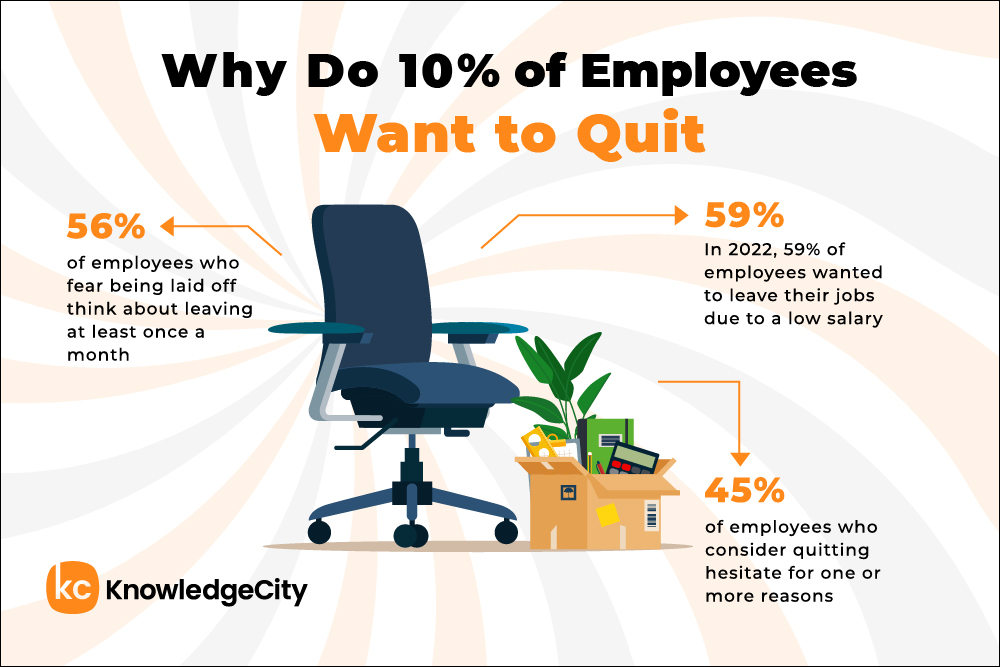Employee retention is an ever-present issue in today’s business landscape. According to Employ, nearly a third of employees quit within the first 90 days of employment. This high turnover rate results in significant rehiring costs, amounting to one-third of an employee’s salary. On top of that, a BambooHR study uncovered that 10% of employees think about quitting their job every day. As we can see from these statistics, employee retention in 2023 is a struggle.
HR management has a huge responsibility when it comes to employee retention, and any given company’s resilience and success depend on its efforts. This article will examine the BambooHR study in greater detail and explore why employees quit their jobs. We’ll also give you actionable tips to boost employee retention in 2023.

1 in 10 Employees Think About Quitting Daily
Many employees think about quitting their job now and again, though not necessarily every single day. To look at things differently, BambooHR found that 75% of employees have considered leaving their job in the last year. This is a sizable proportion of workers, which speaks to the employee retention issue hanging over HR managers’ heads.
The main point of these statistics is that employers must look at the employee experience and the factors driving employee turnover. If these issues aren’t discovered and addressed, we could see even more of the same: more employees quitting their jobs and affected companies collapsing from the failure to retain necessary talent.
Why Employees Are Struggling in 2023
We’ve highlighted that employers have a hard time retaining talent. Now, it’s time to shed some light on the employees and why they have difficulty remaining in their current positions. Let’s look at the top reasons why employees quit their jobs in 2023.
The Salary Isn’t Competitive
A survey conducted by Flexjobs in 2022 found that 59% of employees cited a low salary as one of their top reasons for wanting to leave their current job. Though some might accept a job that pays lower than they hoped, others find that their salaries aren’t keeping pace with inflation (43% of BambooHR study participants considering quitting cited this issue).
When the money isn’t sufficient, employees seek out other companies that will pay more.
A Paycheck Is Just a Paycheck
For a long time, employees would flock to employers that offered higher salaries, and high-paying companies could take their pick from there. Money was enough to attract and retain top talent.
Times have changed; though employees still want and need fair compensation, they seek more than just a paycheck. Many of them want the following in addition to good compensation:
- A sense of fulfillment from completing their job duties
- A feeling of purpose when they walk into the office or log in for the day
- To feel like they’re part of a team and that they belong
Employees will look elsewhere for work if workplaces don’t support their employees outside of providing them with a paycheck.
Benefits Are Insufficient
In addition to the issue of salary, benefits are an important determinant of how happy employees are working for a given company.
The BambooHR study found that job seekers state benefits are more important to jobseekers than total compensation. So if an employer doesn’t offer competitive benefits, the right choice for some employees may be to find an employer that does.
They Don’t Feel Heard
Leaders sometimes fail to show their employees that their opinions matter and act dismissive of them. Some regularly solicit feedback from their employees. Others send an employee survey a couple of times a year.
The latter tactic is a real problem, and it compounds when employers fail to respond to negative or constructive feedback. Inaction on the employer’s or HR’s part translates to a lack of trust in the company and is enough for some employees to consider working elsewhere.
There Are Few to No Opportunities for Advancement
Employees usually have a goal in mind when it comes to advancement. Some may be satisfied with working the same job for several years, while others would rather try their luck with a new role.
If HR hires someone who wants to advance and there isn’t a clear path to moving up within the company, that employee may search for opportunities where they can climb the ladder more easily.
Change Initiatives Are Problematic
Many change initiatives target burnout or aim to increase productivity because it’s a good idea for a company to take stock of its weaknesses and make positive changes.
However, change-oriented initiatives that don’t make employees feel secure can harm the relationship between employer and employee. When these initiatives fall through or fail to accomplish the intended effects, employees may give up on the company and seek new opportunities.
Employees Have More Options
In the age of technological advancement, job prospects may come from halfway around the world. Just a couple of decades ago, employees had to make do with a job until another opportunity opened up near them—or they’d have to move away to take another job.
Things are different now. With the increased popularity of remote work, people can cast a much wider net and consider jobs from across the globe. Because of this, they’re much less likely to stay at a job where they’re not happy.
Layoff Fears
Layoffs in 2023 are a hot topic in the U.S., given the large number of high-profile layoffs at companies like Sonos, Grubhub, and Spotify.
The BambooHR study concluded that 56% of employees who fear the threat of layoff think about leaving at least once per month. This evidence suggests that layoff fears negatively affect employee retention.
Your Employees Need Your Help
Despite the issues described, 45% of employees who think about quitting hesitate to do so for one or more of the following reasons:
- They need the income from the job (48%)
- They fear they won’t enjoy the same job security elsewhere (46%)
- They like the benefits at their current position or don’t want to lose them (37%)
- They’re overwhelmed by changing positions and starting over at someplace new (32%)
- They fear we may be on the cusp of a recession and don’t want to be in between jobs (26%)
- They are unsure whether they’ll be able to find a better work environment than their current one (23%)
- They aren’t successful in their search for a new position (15%)
So, in addition to the continual need to keep the right employees on the job, it’s essential to remember that employees are people with struggles. It’s better for them and the business to be happy at their place of work.
What HR Can Do About It
HR can make a monumental difference in the issues driving employees to consider leaving their jobs. The BambooHR study helps to illuminate some strategies that can bring businesses success in employee retention.
Be Transparent About Layoffs
The threat of layoffs can make some employees feel stuck in their current position and push others toward finding another position. That’s why management needs to do something about the threat of layoffs, which the study recommends being transparent about. Here’s how:
- Whenever layoffs are needed, tell your staff
- Specify why layoffs are necessary
- Respectfully and tactfully tell employees who will be laid off
This transparency helps to establish trust among current workers and makes them feel more at ease.
Figure Out How To Keep Employees Happy
Keeping employees happy can bolster employee retention. When employees feel a sense of satisfaction, contentment, and fulfillment with their jobs, they’re more likely to take the good with the bad and continue chugging along.
How do you keep employees happy? Ask them. Surveying employees can offer valuable insight into their thoughts and any concerns they may have.
It’s not enough to solicit employee opinions once a year. Send out and review employee satisfaction surveys often. That way, you’ll be more likely to get a clear idea of what makes your employees tick and reveal tactics that could boost morale.
As a result of soliciting ongoing feedback, you may find that many of your employees need better work-life balance. In such a case, offering partial remote work opportunities or more frequent breaks can make them happier.
Load Up Your Employee Value Proposition
Your employee value proposition, which outlines what the employer offers to employees who work at their organization, should be clear and descriptive. Employees should fully understand the benefits you would provide them.
Holding up your end of the bargain and delivering on the value proposition is equally important. A given employee may have turned down an outside opportunity to work for your company, so it’s imperative to deliver on those promises made upfront. Otherwise, they may become disenchanted with the job and seek other opportunities.
The employee value proposition comprises several components that are critical to the average jobseeker:
- Compensation
- Benefits
- Work culture
- Work environment
- Advancement opportunities
Be specific when drafting this value proposition and welcome questions during the interview process to offer clarification. Share the proposition throughout the company to ensure that all departments are unified.
Work On the Company’s Culture
Management personnel often overlook company culture. This is not advised, given that a company’s culture can profoundly affect how happy employees are and how long they stay at a company. A toxic culture could drive employees away, while a positive culture could keep them around longer.
To work on the company’s culture, take a team-based approach, where you’ll involve team members in discussions centered around the company’s mission, values, and other cultural elements. Take notes of what ideas the team produces, and act based on the meetings’ outcomes.
Many companies have employed a top-down approach to company culture changes, which can be problematic, burning out employees and eroding their trust in the organization. A more organic and helpful way to approach change initiatives is to include employees in the process from the start, allow them to assist in planning any changes, and leave the windows of communication open.
Enable Employees To Move Up the Ladder
Given that a lack of advancement opportunities is one of the top reasons employees leave a job, it’s essential to provide current employees with opportunities for advancement. That’s not to say that employers should give promotions to workers who don’t deserve them, but there should be at least a clear path to advancement.
A good time to talk to employees about career advancement is during performance reviews. Management should consider employees’ career goals and encourage them to develop skills to reach them. And when the time comes to fill a position, promote from within if feasible.
Investing in online employee training can boost retention. It promotes a learning-focused organizational culture, allows for flexible learning on your employees’ terms, and enables them to position themselves for advancement opportunities. Training helps keep employees engaged, which is a major catalyst for employee retention.
Subscribe to Our Newsletter
Join 80,000+ Fellow HR Professionals. Get expert recruiting and training tips straight
to your inbox, and become a better HR manager.

 KnowledgeCity
KnowledgeCity 










